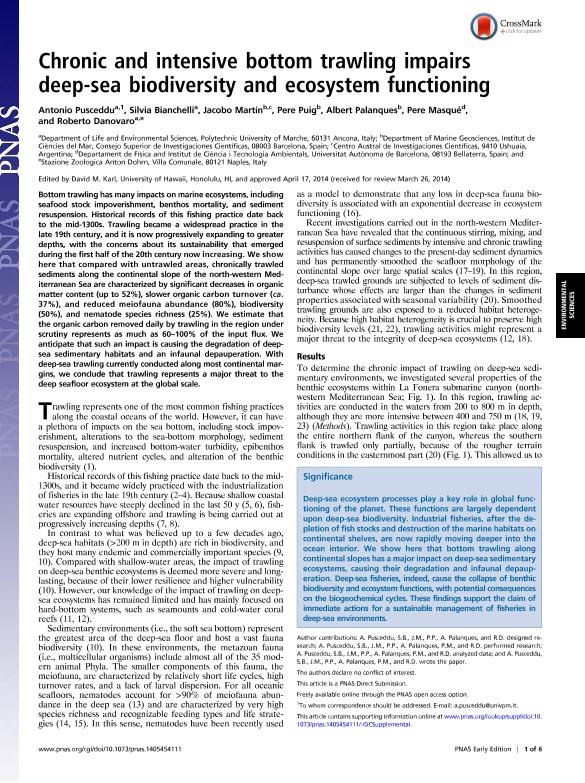Mostrar el registro sencillo del ítem
dc.contributor.author
Pusceddu, Antonio
dc.contributor.author
Bianchelli, Silvia
dc.contributor.author
Martín de Nascimento, Jacobo

dc.contributor.author
Puig, Pere
dc.contributor.author
Palanques, Albert
dc.contributor.author
Masqué, Pere
dc.contributor.author
Danovaro, Roberto
dc.date.available
2016-08-01T20:48:20Z
dc.date.issued
2014-04
dc.identifier.citation
Pusceddu, Antonio; Bianchelli, Silvia; Martín de Nascimento, Jacobo; Puig, Pere; Palanques, Albert; et al.; Chronic and intensive bottom trawling impairs deep-sea biodiversity and ecosystem functioning; National Academy of Sciences; Proceedings of the National Academy of Sciences of The United States of America; 111; 24; 4-2014; 8861–8866
dc.identifier.issn
0027-8424
dc.identifier.uri
http://hdl.handle.net/11336/6856
dc.description.abstract
Bottom trawling has many impacts on marine ecosystems, including seafood stock impoverishment, benthos mortality, and sediment resuspension. Historical records of this fishing practice date back to the mid-1300s. Trawling became a widespread practice in the late 19th century, and it is now progressively expanding to greater depths, with the concerns about its sustainability that emerged during the first half of the 20th century now increasing. We show here that compared with untrawled areas, chronically trawled sediments along the continental slope of the north-western Mediterranean Sea are characterized by significant decreases in organic matter content (up to 52%), slower organic carbon turnover (ca. 37%), and reduced meiofauna abundance (80%), biodiversity (50%), and nematode species richness (25%). We estimate that the organic carbon removed daily by trawling in the region under scrutiny represents as much as 60–100% of the input flux. We anticipate that such an impact is causing the degradation of deep-sea sedimentary habitats and an infaunal depauperation. With deep-sea trawling currently conducted along most continental margins, we conclude that trawling represents a major threat to the deep seafloor ecosystem at the global scale.
dc.format
application/pdf
dc.language.iso
eng
dc.publisher
National Academy of Sciences

dc.rights
info:eu-repo/semantics/openAccess
dc.rights.uri
https://creativecommons.org/licenses/by-nc-sa/2.5/ar/
dc.subject
Anthropogenic Impacts
dc.subject
Trawling
dc.subject
Meiofauna
dc.subject
Deep Sea Sediments
dc.subject.classification
Biología Marina, Limnología

dc.subject.classification
Ciencias Biológicas

dc.subject.classification
CIENCIAS NATURALES Y EXACTAS

dc.title
Chronic and intensive bottom trawling impairs deep-sea biodiversity and ecosystem functioning
dc.type
info:eu-repo/semantics/article
dc.type
info:ar-repo/semantics/artículo
dc.type
info:eu-repo/semantics/publishedVersion
dc.date.updated
2016-08-01T18:17:20Z
dc.journal.volume
111
dc.journal.number
24
dc.journal.pagination
8861–8866
dc.journal.pais
Estados Unidos

dc.journal.ciudad
Washington
dc.description.fil
Fil: Pusceddu, Antonio. Polytechnic University of Marche. Department of Life and Environmental Sciences; Italia
dc.description.fil
Fil: Bianchelli, Silvia. Polytechnic University of Marche. Department of Life and Environmental Sciences; Italia
dc.description.fil
Fil: Martín de Nascimento, Jacobo. Consejo Superior de Investigaciones Cientificas. Instituto de Ciencias del Mar; España. Consejo Nacional de Investigaciones Científicas y Técnicas. Centro Austral de Investigaciones Científicas; Argentina
dc.description.fil
Fil: Puig, Pere. Consejo Superior de Investigaciones Cientificas. Instituto de Ciencias del Mar; España
dc.description.fil
Fil: Palanques, Albert. Consejo Superior de Investigaciones Cientificas. Instituto de Ciencias del Mar; España
dc.description.fil
Fil: Masqué, Pere. Universitat Autonoma de Barcelona; España
dc.description.fil
Fil: Danovaro, Roberto. Polytechnic University of Marche. Department of Life and Environmental Sciences; Italia. Stazione Zoologica Anton Dohrn; Italia
dc.journal.title
Proceedings of the National Academy of Sciences of The United States of America

dc.relation.alternativeid
info:eu-repo/semantics/altIdentifier/url/http://www.pnas.org/content/111/24/8861.abstract
dc.relation.alternativeid
info:eu-repo/semantics/altIdentifier/doi/10.1073/pnas.1405454111
dc.relation.alternativeid
info:eu-repo/semantics/altIdentifier/doi/http://dx.doi.org/10.1073/pnas.1405454111
Archivos asociados
